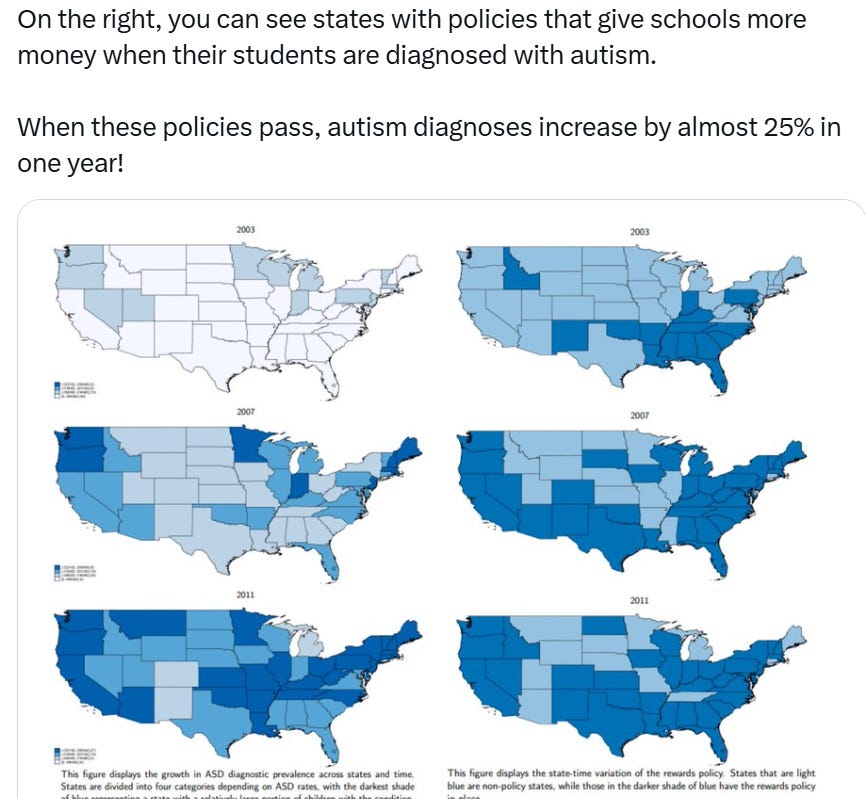Links for September, 2025
Current Things, Comics and Fantasy Books
It’s a short installment, as I haven’t come across much on the internet this month — or rather, I’ve come across most of the same stuff as most of the rest of you, with everyone talking about the same few Current Things. Current Things aren’t my brand here, but I suppose I’ll mention a few.
Current Things
Tanner Greer offers reflections on the late Charlie Kirk and the significance of his assassination: “Bullets and Ballots: The Legacy of Charlie Kirk.”
I’d barely heard of the man before his assassination, but I’ve since gathered that many are circulating inaccurate or garbled quotations that make him appear extremist and, I suppose some think, deserving of death.
People’s readiness to believe the worst about the Outgroup isn’t surprising if you know much about human conflict. But I will admit to surprise at the amount of dancing on the man’s grave. Arnold Kling compares it to the celebrations of the October 7 massacre.
Another effect of partisanship is quickness to forget the wrongs of the Ingroup. Consider those honoring the death (by natural causes) of former Black Liberation Army soldier Assata Shakur. The AP describes her as a “liberation activist,” but the BLA was a Marxist guerilla group whose “activism” consisted of robbing banks and ambush shootings of police officers (at least 15 shot, 8 killed). Shakur was convicted of robbery and murder. Nonetheless, the Chicago Teacher’s Union sings her praises. I cover the BLA’s activities in my posts on Bryan Burroughs’s book Days of Rage.
Polarization produces other absurdities. I half expect US Health Secretary Kennedy’s playing up the association between autism and acetaminophen (the drug in Tylenol) will lead to stores in Red States pulling it from shelves, while TikTokers chug it to prove the MAGAs wrong.
Tylenol was around for long decades before autism diagnoses spiked, so it is unlikely the association is causal. (Update 10/3: And it is likely not even a real correlation) But if not Tylenol or vaccines, what is causing the autism epidemic? Cremieux Recueil has a more realistic take on the rise in autism:
The reality is much more mundane; the truth is that larger and larger portions of the population are being diagnosed with autism. This distinction is key to understanding the epidemic. The epidemic is artefactual: not real, not about autism actually becoming more common, not about neurological disorders proliferating, etc. etc. etc.
I’d pretty much taken that for granted — mental health fields are subject to concept creep, where normal sadness becomes depression, being emotionally distressed becomes trauma, and really liking something becomes addiction. Of interest in this case is the financial incentives for autism diagnosis:
Not So Current Things
Archaeologists have found evidence that Europeans 13,000 years ago used azurite as blue pigment, overturning the idea that they were limited to black and red. The mineral azurite is not to be confused with the plant-based blue woad that the Celts wore in battle.
In early modern Europe, sorcerers and diviners were known as “cunning folk.” Though a few were denounced as witches, they were generally understood to be distinct from them, and warding off witchcraft was one of the services they offered. Most probably considered themselves Christian, though the lay Christianity of the peasants was often divergent from the theology of the priesthood.
Razib Khan on “How the West Was Wrought.” Being a homeschooler married to an Easterner, I often have occasion to reflect on how strange it is that I start my kids learning about “my” culture by talking about Hebrews in Egypt and Achaeans in Anatolia. Jewish religion, Greek philosophy, and Roman law — what an odd agglomeration.
Call it past or present, but Stone Age Herbalist has an interesting post on “The Bizarre Biology of Birds.” Were we not used to them, we’d think them odder than their dinosaur ancestors.
More Books
Having just finished a long tome on the history of numbers, my reading and audiobook listening lately consists of comics and fantastical fiction.
It only took a few drives to get through an audiobook of C.S. Lewis’s The Screwtape Letters. It’s a witty look at human foibles from a Christian perspective, written as a demon telling his protégé how to lead people estray. Screwtape gives such advice as to avoid tempting a person into a Big Sin like murder, because those can lead to a “What have I done?” realization followed by repentance. Best to keep the road to Hell slow and gradual, all baby steps with no signposts.
Screwtape might have taken a page from Donald Black and advised against large movement of social time.
Saints and Sinners is an anthology from Rippaverse comics. It’s a collection of stories from various writers, with the gimmick that many of them are also well-known Youtubers, some taking their first crack at writing. I liked the anthology concept, but was disappointed at how few entries felt like complete stories — it seems more like teaser trailers for potential future projects. Maybe it was meant to be that, or maybe they’ll do an anthology Part 2 that continues the stories. My favorite entry was by the Soska Sisters, who had a reputation in comics prior to joining the company. They tell a sports story from the world of professional wrestling, in which an underdog rises and a bully gets his comeuppance.
Also in comics, I’ve frequently been called upon to read with my son stories from two collections I gifted him on his birthday.
One is The Amazing Spiderman (Penguin Classics Marvel Collection), a compendium of the Stan Lee and Steve Ditko’s original run with the character, including his early appearances in Amazing Fantasy.
I grew up reading the Spiderman comics of the early 90s, but never read the original run that made the character famous. Reading them now I can see how innovative they were, as the simple superhero power fantasy is complicated by Peter Parker’s personal life. He spends multiple early issues just trying to find a way to help his Aunt May pay the bills in the wake of Uncle Ben’s death — it’s as much an origin story of Peter Parker, local photographer, as it is for Spiderman.
The collection also includes other stand-alone stories from the Amazing Fantasy anthology series; mostly little crime dramas with EC-style twist endings.
The other gift book was a second volume of the Carl Barks Uncle Scrooge collection: The Cave of Ali Baba. At first, I was miffed to discover about a third of the volume’s length are taken up with stories of another Duckberg character, the ill-fated inventor Gyro Gearloose. But those are also good, and my son likes them as well. I’ve taken to calling him “Gyro” whenever he conjures up a little invention in his play.
Pray for my limited time, as I’ve started a new fantasy series with Larry Correia’s Son of the Black Sword. Correia’s an interesting case. I read his Monster Hunter International years ago because I wanted a monster book at Halloween time. It’s his first book, and to be honest, you can tell: It has clunky narration with an obvious self-insert protagonist. I wouldn’t give it a firm recommendation unless you’re very specifically looking for light-hearted monsters-and-guns schlock. But there were these little flashes of brilliance and mirth in his world-building, and the story structure was solid, so that made me think the guy had potential.
So I decided to give his later Hard Magic series a try and found it much better. Set in an alternate 1930s where people with magical powers have been known to the world for some time, it blends element of alt-history, fantasy, hardboiled, and the X-Men. I would give this a strong recommendation if any two of those genre elements interest you.
I suppose practice makes perfect, because Son of the Black Sword, the first entry in an epic fantasy series, is extremely good. It strikes me as much more polished and sophisticated than his early work. The fictional setting clearly takes inspiration from classical Indian civilization, which is an interesting departure from settings that resemble medieval Europe. The series also takes inspiration from Robert E. Howard’s Conan stories, and I think before it’s done it might be in dialogue with A Song of Ice and Fire as much as with Conan. But mentioning Ice and Fire reminds me of my policy to never recommend a genre series until I see how, or even if, it ends. My understanding is this series is at least completed, so I’ll report back with a full assessment when I make it to the end.
Thanks for reading! If you enjoyed, please leave a tip at this Stripe link or become a subscriber with the button below.
Substacks cited above:
; ; ; ;



